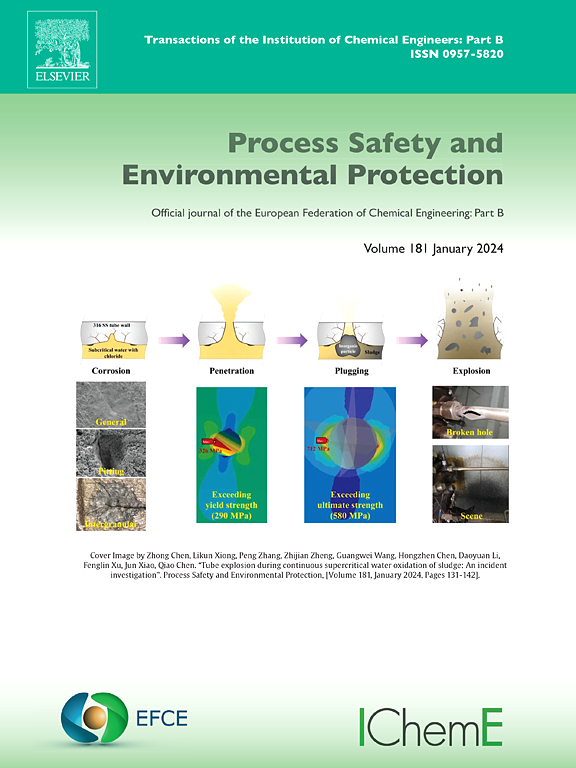高压氢气向空气释放自燃的数值研究
IF 7.8
2区 环境科学与生态学
Q1 ENGINEERING, CHEMICAL
引用次数: 0
摘要
氢是一种清洁、高效的能源,正受到全世界的关注。然而,高压氢气释放引起的自燃是一个潜在的危险。自燃机制和随后的火焰演变,特别是高压氢释放到空气中,仍未得到解决。此外,目前只研究了低于30MPa的氢气释放压力对自燃可能性的影响。相比之下,本研究首次考虑高压释氢(35~140MPa)对自燃特性的影响。此外,还考虑了释放直径和孔厚的影响。详细讨论了不同释放压力下自燃过程的压力、温度和物质质量分数特征。当释放压力从35MPa增加到140MPa时,点火延迟时间从0.71 μs减少到0.36 μs。结果表明,点火首先发生在孔洞边界处。此外,孔的厚度和直径对激波和火焰的演化也有重要影响。足够的预混料和冲击加热空气温度是导致自燃的主要原因。本文章由计算机程序翻译,如有差异,请以英文原文为准。
Numerical study on spontaneous ignition of high-pressure hydrogen release into air
Hydrogen is attracting worldwide attention since it’s a clean and efficient energy. However, spontaneous ignition caused by high-pressure hydrogen release is a potential risk. The mechanism of spontaneous ignition and following flame evolution, especially high-pressure hydrogen release into the air, remained unresolved. Moreover, currently only the effect of hydrogen release pressure below 30 MPa on the possibility of spontaneous ignition has been investigated. In contrast, this study is the first time to consider the effect of high-pressure hydrogen release (35–140 MPa) on spontaneous ignition characteristics. Furthermore, the effects of release diameters and hole thicknesses were also taken into account. The characteristics of pressure, temperature and species mass fraction during spontaneous ignition at different release pressures were discussed in detail. The ignition delay time decreases from 0.71 μs to 0.36 μs when the release pressure increases from 35 MPa to 140 MPa. It is found that the ignition first takes place at the hole boundary. Moreover, Hole thicknesses and diameters have important effects on shock wave and flame evolutions. Enough premixed mixture and shock-heated air temperature are responsible for the occurrence of spontaneous ignition.
求助全文
通过发布文献求助,成功后即可免费获取论文全文。
去求助
来源期刊

Process Safety and Environmental Protection
环境科学-工程:化工
CiteScore
11.40
自引率
15.40%
发文量
929
审稿时长
8.0 months
期刊介绍:
The Process Safety and Environmental Protection (PSEP) journal is a leading international publication that focuses on the publication of high-quality, original research papers in the field of engineering, specifically those related to the safety of industrial processes and environmental protection. The journal encourages submissions that present new developments in safety and environmental aspects, particularly those that show how research findings can be applied in process engineering design and practice.
PSEP is particularly interested in research that brings fresh perspectives to established engineering principles, identifies unsolved problems, or suggests directions for future research. The journal also values contributions that push the boundaries of traditional engineering and welcomes multidisciplinary papers.
PSEP's articles are abstracted and indexed by a range of databases and services, which helps to ensure that the journal's research is accessible and recognized in the academic and professional communities. These databases include ANTE, Chemical Abstracts, Chemical Hazards in Industry, Current Contents, Elsevier Engineering Information database, Pascal Francis, Web of Science, Scopus, Engineering Information Database EnCompass LIT (Elsevier), and INSPEC. This wide coverage facilitates the dissemination of the journal's content to a global audience interested in process safety and environmental engineering.
 求助内容:
求助内容: 应助结果提醒方式:
应助结果提醒方式:


